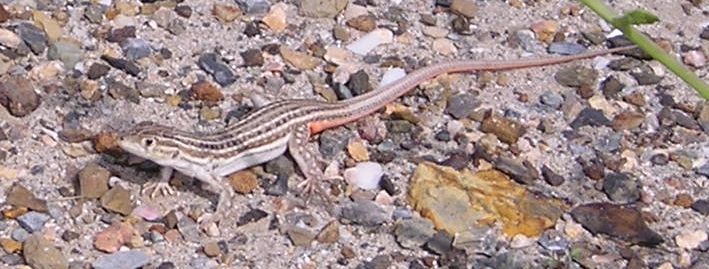Fringe-Fingered Lizard
(August 2006) The Fringe-Fingered Lizard (Acanthodactylus erythrurus) is endemic to Iberia and North Africa, probably originating from the latter. Absent from Northern Spain, and the Balearics and the Canaries. Its preferred habitat is dry, flattish sandy scrub and shows a preference for dunes . Its English name is in reference to its long “fingers” enabling it to run over fine sand without sinking in. Takes insects and spiders with a particular perchant for ants (64% of diet in Doñana Here at vertebrados ibericos) and more than occasionally the young of its own kind. In turn is preyed on by reptiles (Coronella girondica, Malpolon monspessulanus, Vipera latastei and Chamaeleo chamaeleons), birds (Bubulcus ibis, Lanius excubitor, Upupa epops, Circus pygargus, Buteo buteo, Falco tinnunculus, Tyto alba) and Egyptian mongoose (Herpestes ichneumon). Young are also know to fall to black widow spiders (Latrodectus) in Granada. [all from above link]
This photo of a Fringe-Fingered Lizard was sent to me by Jill Schinas. She noted:

“attached is a photo of a little lizard who lives hereabouts, in the sandy, arid scrub-land on La Manga (Murcia). His main features are his brown and white pin-striped suit and his red under-carriage. (He is only red under his tail and his back legs, not under his belly.) Can you identify? ”
Once again thanks to reptile expert Cyberlizard for identifying this. Read what he has to say about Fringe-fingered lizards and more here (best English European reptile site on the web)
Full treatment in Spanish here http://www.vertebradosibericos.org/reptiles/acaery.html
Acanthodactylus erythrurus – Lagartija colirroja (spanish); Sargantana cua-roja (catalan.), Sugandila buztangorria (Basque)
- #3 (no title)
- Birds
- Geography
- Environmental issues in Spain
- Forests in Spain
- Literature and accounts on Spain
- Mountains
- Nature conservation in Spain
- Other geographical features in Spain
- Paleotology and prehistory
- Rivers, lakes and wetlands
- Seas around Spain
- Spanish climate
- Traditional architecture and farming
- Volcanoes and earthquakes
- Mammals
- Barbary macaque
- Bats
- Bears
- Goats, deer and boar
- Hedgehogs
- Iberian lynx
- Martens, mink, stoats and weasels
- Other carnivores in Spain
- Other mammals
- Rabbits and hares
- Rodents
- Sea mammals
- Wolves
- Other wildlife
- Regions
- Andalucia
- Albufera de Adra
- Bahia de Cadiz
- Cabo de Gata-Nijar
- Climate of Andalusia
- Doñana
- Flora and wildlife of Andalusia
- Geography of Andalusia
- Grazalema
- History of Andalucia
- Laguna de Fuente de Piedra
- Las Dehesas de Sierra Morena
- Las Sierras de Cazorla y Segura
- Los Alcornocales
- Nature reserves in Andalusia
- Ordiel Marshes
- Sierra Nevada
- Andorra
- Aragon
- Castilla y León
- Catalonia
- Aiguamolls de l’Empordà Natural Park
- Aigüestortes i Estany de Sant Maurici
- Birding sites in Catalonia
- Cap de Creus
- Catalonia earthquake of 1428
- Congost de Mont-rebei / Mont-rebei gorge
- Delta del Ebro
- Els Ports
- Garraf
- Lake Banyoles
- Lerida Steppes
- Montseny
- Pica d’Estats
- Sant Llorenç del Munt
- Serra de Montsec
- Sierra de Cadi
- Navarra
- The Basque Country
- Valencia
- Andalucia
- Tourism
- Adventure sports and outdoor activities in Spain
- Alternative technologies in Spain
- Art and photography
- EFL
- Animal classification
- Animal English for children
- Animal sounds quiz
- Animal words revision
- Animals and their young
- Animals homes
- Bird quiz
- Definitions
- EFL nature links
- English nature quizzes (java)
- Insects quiz
- Male and female animals
- Nature quizzes for children
- Odd one out
- TEFL word lists
- Wild animals quiz
- Farming in Spain
- Nature and wildlife tourism in Spain
- Nature bookshops, equipment & supplies
